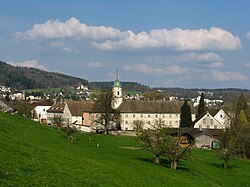Fahr Monastery
| Kloster Fahr | |

Fahr Monastery as seen from the west, Unterengstringen in the background
|
|
| Monastery information | |
|---|---|
| Other names | Fahr Monastery; Fahr Nunnery |
| Order | Order of Saint Benedict |
| Established | 22 January 1130 |
| Mother house | Kloster Einsiedeln |
| Dedicated to | Our Lady |
| Diocese | Roman Catholic Diocese of Basel |
| Controlled churches | 3 |
| People | |
| Founder(s) | Judenta and Luitold von Regensberg |
| Abbot | Urban Federer OSB, Kloster Einsiedeln |
| Prior | Irene Gassmann OSB (since 2003) |
| Site | |
| Location | Würenlos, Canton of Aargau, being an enclave within Unterengstringen, Canton of Zürich, Switzerland |
| Coordinates | 47°24′30.42″N 8°26′21.48″E / 47.4084500°N 8.4393000°ECoordinates: 47°24′30.42″N 8°26′21.48″E / 47.4084500°N 8.4393000°E |
| Public access | allowed |
| Other information | extensive agriculture by the nunnery, monastery shop and restaurant |
Fahr Monastery, (German: Kloster Fahr) is a Benedictine monastery of nuns located in the Swiss municipality of Würenlos in the canton of Aargau. Located in different cantons, Einsiedeln Abbey and Fahr Monastery form a double monastery, ruled by the Abbot of Einsiedeln. Fahr and Einsiedeln are perhaps the only such community still to exist.
The monastery historically was located in an exclave of the canton of Aargau within the municipality of Unterengstringen in the canton of Zürich in the Limmat Valley. The nuns' monastery had not been part of a political municipality, although some administrative tasks have been carried out by the Würenlos authorities since the 19th century and the nuns were always allowed to fulfill their political rights (voting, etc.) in Würenlos. Since 1 January 2008 Fahr Monastery has been a part of Würenlos. The nunnery has its own postal code, 8109 Kloster Fahr.
The monastery is first mentioned in AD 1130 as Vare (an old term used for "ferry"). The lands were donated by the House of Regensberg. On 22 January 1130 Lütold II and his son Lütold III and his wife Judenta handed over lands and estates on the shore of the Limmat around Weiningen and Unterengstringen-Oberengstringen to the Einsiedeln Abbey to establish a Benedictine monastery for nuns. The Chapel of St. Nicholas already stood on the land. This may have been connected with the death of Lütold I in 1088 while engaged in battle against the forces of the Abbey of Einsiedeln. The monastery was dedicated to Our Lady. In addition to the medieval St. Nikolaus-Kapelle (Saint Nicholas chapel), built around 10th century AD and now called St. Anna-Kapelle, and the late medieval church of the monastery, the parish church of Weiningen were subordinated to the monastery.
...
Wikipedia


